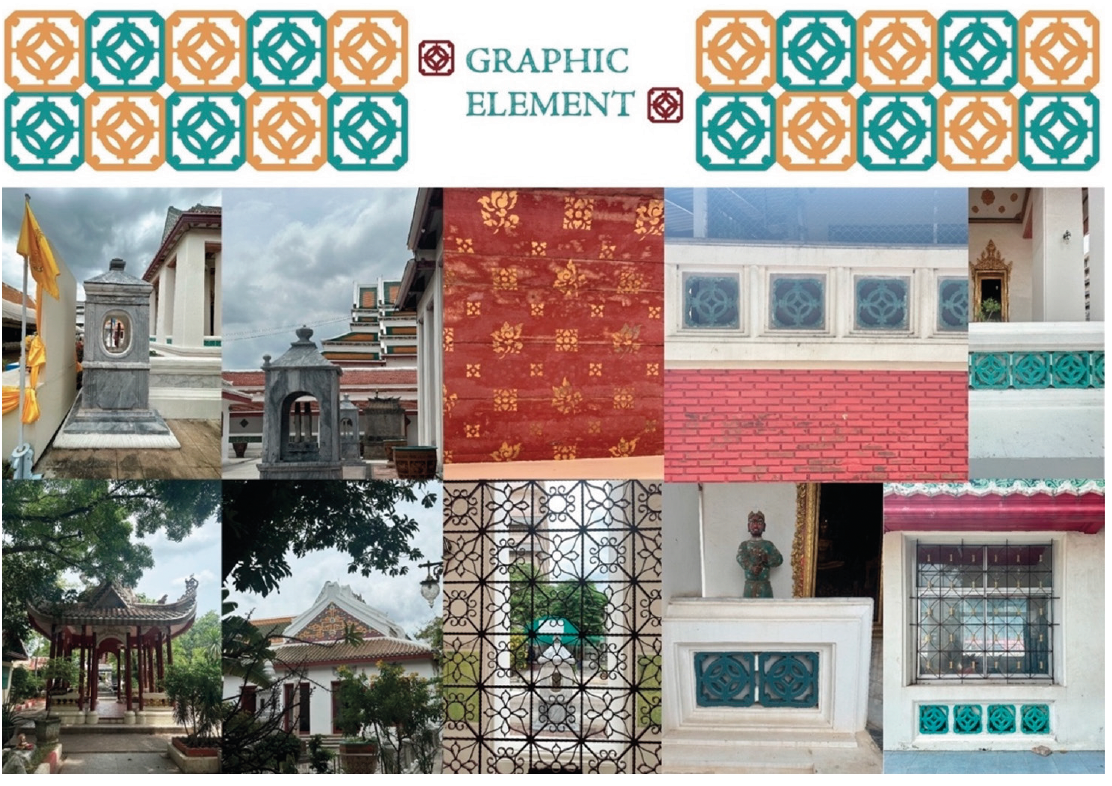Multicultural Belief, Faith, and Behavior of District’s Aged Society to The Identity of Creative Recreation Area for A Cultural Tourism: A Case Study of Wutthakat Community, Jomthong Districts, Bangkok
DOI:
https://doi.org/10.69598/decorativeartsjournal.3.31%20-%2053Keywords:
Multicultural, Aged Society, dentity, Creative Recreation Area, Cultural TourismAbstract
The Wutthakat community is located in the area of an ancient temple, it has royal architecture in the reign of King Rama III and the community has a diverse heritage of wisdom in the community. The research project was performed out using a mixed methods research design. A group of local elders was interviewed for qualitative study. Local artists, creatives, agency representatives, academics, and specialists to be evaluated, synthesized, and combined with theories to design a creative recreation area for cultural tourism.
The study indicated that 1) Wutthakat community context Famous tourist destinations, Thai-Chinese cultural resources influenced by King Rama III, and intellectual heritage like the Pi-phat Kru Thongkham group are its strengths, Cockatoo-tiger stabbing game, etc. 2) Wutthakat seniors live simply, be self-sufficient and happy with your home and enjoy group fun and relaxing activities. 3) The possibility of local expenses to develop an identity that matches community elderly behavior and encourage beautiful creation Preservation and emphasis on the area's original attractiveness are its goals.
Based on study results Researchers advise using research results and future research. Local leaders and residents It increase involvement and comprehension. Designing a creative cultural tourism leisure area. In order to enhance the overall well-being of the elderly population and foster the establishment of a secure community. The individual expresses a willingness to engage in sustainable adaptation.
The study indicated that 1) Wutthakat community context Famous tourist destinations, Thai-Chinese cultural resources influenced by King Rama III, and intellectual heritage like the Piphat Kru Thongkham group are its strengths. Cockatoo-tiger stabbing game, etc. 2) Wutthakat seniors live simply. Be self-sufficient and happy with your home. and enjoy group fun and relaxing activities. 3) The possibility of local expenses to develop an identity that matches community elderly behavior. and encourage beautiful creation Preservation and emphasis on the area's original attractiveness are its goals.
Based on study results Researchers advise using research results and future research. Local leaders and residents It increase involvement and comprehension. Designing a creative cultural tourism leisure area. In order to enhance the overall well-being of the elderly population and foster the establishment of a secure community. The individual expresses a willingness to engage in sustainable adaptation.
Key word: Multiculture, Aged Society, The Identity, Creative Recreation Area, Cultural Tourism
References
จรัสวรรณ เทียนประภาส และพัชรี ตันศิริ. (2536). การพยาบาลผู้สูงอายุ (พิมพ์ครั้งที่ 3). กรุงเทพฯ: คณะพยาบาลศาสตร์ มหาวิทยาลัยมหิดล.
ชณัฎฐ์ พงศ์ธราธิก, สุมนรตรี นิ่มเนติพันธ์และอนันต์ มาลารัตน์. (2564). การพัฒนากลยุทธ์การท่องเที่ยวเชิงวัฒนธรรมในจังหวัดประจวบคีรีขันธ์. วารสาร มจร พุทธปัญญาปริทรรศน์, 6(3), 77-91.
พิศิษฎ์ คุณวโรฒม์. (2509). อัตลักษณ์และกระบวนการต่อสู้เพื่อชีวิตของผู้ติดเชื้อ HIV. คณะสังคมวิทยาและมานุษยวิทยา
มหาวิทยาลัยธรรมศาสตร์, กรุงเทพฯ.
มนสิชา อินทจักร. (2552). การท่องเที่ยวเชิงวัฒนธรรมในประเทศไทยสำหรับนักท่องเที่ยวสูงอายุชาวญี่ปุ่น. วารสารวิชาการ
อิเล็กทรอนิกส์การท่องเที่ยวไทยนานาชาติ. ปี 2552 ฉบับที่ 1 หน้า 1-10.
วนิดา ตรีสวัสดิ์. (2555). วัดมอญจังหวัดราชบรุ ี: การจัดการภูมิทัศน์และความหมายของอัตลักษณ์ชุมชน. วารสารร่มพฤกษ์ ปีที่
ฉบับที่2: 20-21.
พระธรรมปิฎก, (ป.อ.ปยุตฺ โตฺ ). (2553). พจนานกรมพุทธศาสน์ ฉบับประมวลศัพท์ (พิมพ์ครั้งที่9). มหาจุฬาลงกรณราชวิทยาลัย
ราชบัณฑิตยสถาน. (2532). พจนานุกรมศัพท์สังคมวิทยา อังกฤษ – ไทย (ฉบับราชบัณฑิตสถาน). อัมรินทร์พริ้นติ้ง
เสริมศักดิ์ ขุนพล. (2557). การออกแบบและพัฒนาสื่อสิ่งพิมพ์เพื่อให้ความรู้เกี่ยวกับอัตลักษณ์ทางวัฒนธรรมของ ชุมชนเกาะยอ. รายงานวิจัย คณะมนุษยศาสตร์และสังคมศาสตร์ มหาวิทยาลัยทักษิณ.
Eriksen, T. H. (2001). Between universalism and relativism: a critique of the UNESCO concept of
culture. Culture and rights: Anthropological perspectives, 127-148.
Smith, V.L. (1997) ‘The four Hs of tribal tourism: Acoma – A Pueblo case study’, in Cooper, C. and Wanhill, S. (eds) Tourism Development: Environmental and Community Issues, London: John Wiley and Sons, pp. 141–151.
Woodward, K. (Ed.). (1997). Identity and difference (Vol. 3). Sage.

Downloads
Published
How to Cite
License
Copyright (c) 2024 DEC Journal

This work is licensed under a Creative Commons Attribution-NonCommercial-NoDerivatives 4.0 International License.
Published by Academic Affairs Division, Faculty of Decorative Arts, Silpakorn University. The copyright of the article belongs to the article owner. Published articles represent the views of the authors. The editorial board does not necessarily agree with and is not responsible for the content of such articles.


